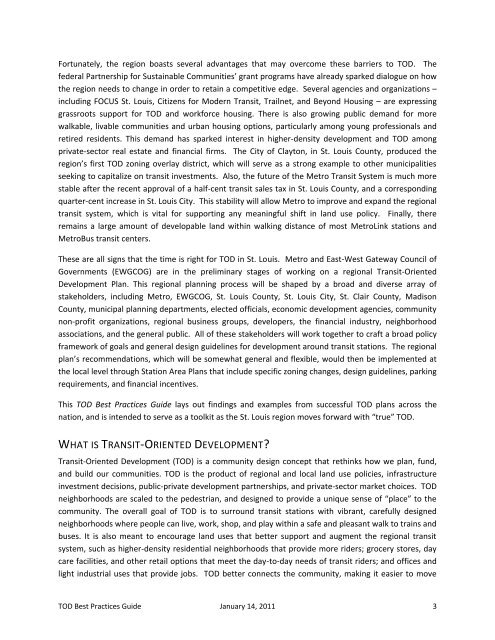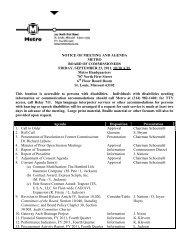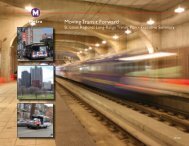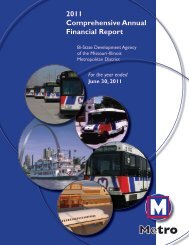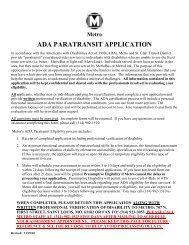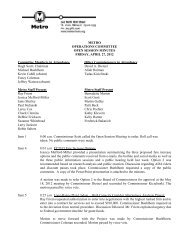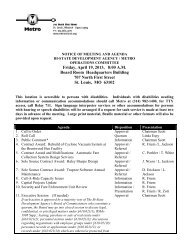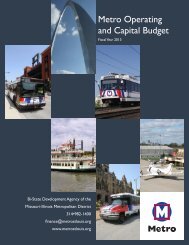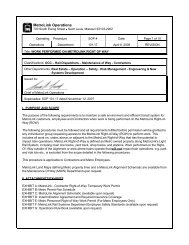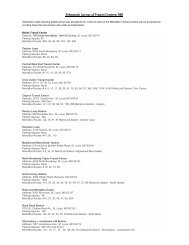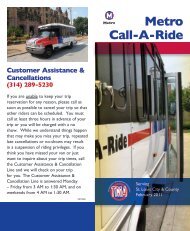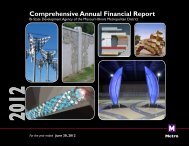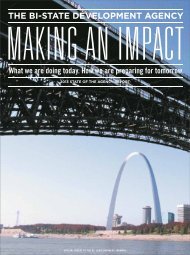st.louis regional transit -oriented development best ... - Metro Transit
st.louis regional transit -oriented development best ... - Metro Transit
st.louis regional transit -oriented development best ... - Metro Transit
You also want an ePaper? Increase the reach of your titles
YUMPU automatically turns print PDFs into web optimized ePapers that Google loves.
Fortunately, the region boa<strong>st</strong>s several advantages that may overcome these barriers to TOD. The<br />
federal Partnership for Su<strong>st</strong>ainable Communities’ grant programs have already sparked dialogue on how<br />
the region needs to change in order to retain a competitive edge. Several agencies and organizations –<br />
including FOCUS St. Louis, Citizens for Modern <strong>Transit</strong>, Trailnet, and Beyond Housing – are expressing<br />
grassroots support for TOD and workforce housing. There is also growing public demand for more<br />
walkable, livable communities and urban housing options, particularly among young professionals and<br />
retired residents. This demand has sparked intere<strong>st</strong> in higher-density <strong>development</strong> and TOD among<br />
private-sector real e<strong>st</strong>ate and financial firms. The City of Clayton, in St. Louis County, produced the<br />
region’s fir<strong>st</strong> TOD zoning overlay di<strong>st</strong>rict, which will serve as a <strong>st</strong>rong example to other municipalities<br />
seeking to capitalize on <strong>transit</strong> inve<strong>st</strong>ments. Also, the future of the <strong>Metro</strong> <strong>Transit</strong> Sy<strong>st</strong>em is much more<br />
<strong>st</strong>able after the recent approval of a half-cent <strong>transit</strong> sales tax in St. Louis County, and a corresponding<br />
quarter-cent increase in St. Louis City. This <strong>st</strong>ability will allow <strong>Metro</strong> to improve and expand the <strong>regional</strong><br />
<strong>transit</strong> sy<strong>st</strong>em, which is vital for supporting any meaningful shift in land use policy. Finally, there<br />
remains a large amount of developable land within walking di<strong>st</strong>ance of mo<strong>st</strong> <strong>Metro</strong>Link <strong>st</strong>ations and<br />
<strong>Metro</strong>Bus <strong>transit</strong> centers.<br />
These are all signs that the time is right for TOD in St. Louis. <strong>Metro</strong> and Ea<strong>st</strong>-We<strong>st</strong> Gateway Council of<br />
Governments (EWGCOG) are in the preliminary <strong>st</strong>ages of working on a <strong>regional</strong> <strong>Transit</strong>-Oriented<br />
Development Plan. This <strong>regional</strong> planning process will be shaped by a broad and diverse array of<br />
<strong>st</strong>akeholders, including <strong>Metro</strong>, EWGCOG, St. Louis County, St. Louis City, St. Clair County, Madison<br />
County, municipal planning departments, elected officials, economic <strong>development</strong> agencies, community<br />
non-profit organizations, <strong>regional</strong> business groups, developers, the financial indu<strong>st</strong>ry, neighborhood<br />
associations, and the general public. All of these <strong>st</strong>akeholders will work together to craft a broad policy<br />
framework of goals and general design guidelines for <strong>development</strong> around <strong>transit</strong> <strong>st</strong>ations. The <strong>regional</strong><br />
plan’s recommendations, which will be somewhat general and flexible, would then be implemented at<br />
the local level through Station Area Plans that include specific zoning changes, design guidelines, parking<br />
requirements, and financial incentives.<br />
This TOD Be<strong>st</strong> Practices Guide lays out findings and examples from successful TOD plans across the<br />
nation, and is intended to serve as a toolkit as the St. Louis region moves forward with “true” TOD.<br />
WHAT IS TRANSIT-ORIENTED DEVELOPMENT<br />
<strong>Transit</strong>-Oriented Development (TOD) is a community design concept that rethinks how we plan, fund,<br />
and build our communities. TOD is the product of <strong>regional</strong> and local land use policies, infra<strong>st</strong>ructure<br />
inve<strong>st</strong>ment decisions, public-private <strong>development</strong> partnerships, and private-sector market choices. TOD<br />
neighborhoods are scaled to the pede<strong>st</strong>rian, and designed to provide a unique sense of “place” to the<br />
community. The overall goal of TOD is to surround <strong>transit</strong> <strong>st</strong>ations with vibrant, carefully designed<br />
neighborhoods where people can live, work, shop, and play within a safe and pleasant walk to trains and<br />
buses. It is also meant to encourage land uses that better support and augment the <strong>regional</strong> <strong>transit</strong><br />
sy<strong>st</strong>em, such as higher-density residential neighborhoods that provide more riders; grocery <strong>st</strong>ores, day<br />
care facilities, and other retail options that meet the day-to-day needs of <strong>transit</strong> riders; and offices and<br />
light indu<strong>st</strong>rial uses that provide jobs. TOD better connects the community, making it easier to move<br />
TOD Be<strong>st</strong> Practices Guide January 14, 2011 3


